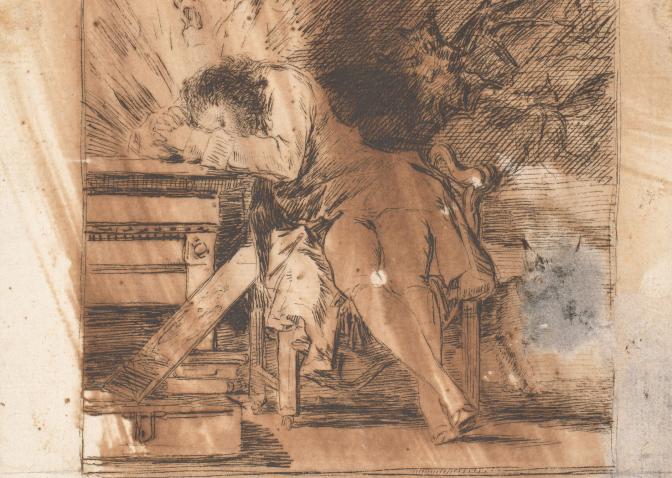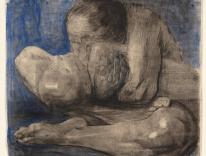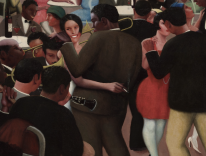In 1792, the Spanish painter Francisco Goya (1746–1828) became gravely ill. His convalescence and recovery lasted for more than a year, leaving him completely deaf. (Lead poisoning was suspected.) Had he died right then, at the age of forty-six, Goya would have been remembered as a competent, even elegant, Rococo painter with realist tendencies, but nothing more. Instead, his illness transformed him into an extraordinary artist, one marked by great emotional depth and inventive formal technique.
There’s no denying Goya’s prowess as a painter. Just recall his arresting portraits and still lifes, or his masterful frescoes in San Antonio de la Florida Chapel in Madrid. There’s also his powerful Executions of the Third of May 1808 (1814) and his unsettling Black Paintings (1819–23), made near the end of his life. To fully grasp the extent of Goya’s achievements, though, one must consider his drawings and prints.
Beginning in the mid-1790s, Goya began creating libretas de apuntes (journal albums). He used them to sketch a range of visions and impressions of the world with markedly different styles. By the time he died in exile in Bordeaux, Goya had produced some nine hundred drawings and more than three hundred prints, etched in both aquatint and lithograph. (The libretas were later taken apart and dispersed, and now exist as individual works.) Since the 1960s, scholars have acknowledged Goya’s graphic output as foundational for European and global art. Together with Dürer and Rembrandt, he paved the way for artists like Honoré Daumier, Georges Rouault, Käthe Kollwitz, George Grosz, and José Clemente Orozco. His influence continues right up to the present day in printmakers as diverse as Kiki Smith and Juan Sánchez.
It’s appropriate, then, that the Metropolitan Museum in New York has just opened a new exhibition (the first in recent memory to take place on U.S. soil) focused entirely on Goya’s drawings and prints. Containing more than a hundred works (mostly from the Met’s permanent collection, supplemented with loans from the Prado, the Biblioteca Nacional in Madrid, and other libraries in Boston and New York), the show fills three modestly sized galleries. Organized by Mark McDonald, also the principal author of the show’s excellent catalog, it’s especially refreshing during these days of visual overload. Set against sober, neutral walls, Goya’s small, powerful works take us from looking into seeing.

Proceeding chronologically, the show spans nearly half a century. The earliest prints on display are Goya’s rather clumsy copies of paintings by Velázquez, dating from the late 1770s. The last are the bold lithographs of The Bulls of Bordeaux (1825), along with a handful of drawings made shortly before the artist’s death. In between we find several well-known series, including Los Caprichos, a satirical set of images from 1799; The Disasters of War, a response to the Napoleonic occupation of Spain from 1808–14; the Tauromaquia (1816); and the bizarre Disparates or Proverbios (1815–19), published posthumously more than four decades later. There are also a few single prints.
One of them, Seated Giant, stands out. A full foot tall, it’s Goya’s largest. The giant, filling the frame, is depicted in a night scene. His back turned, he seems to twist toward us, the harsh realism of his body (and its potential for violence) evoking mystery, even fear. This is Goya the master of the grotesque and the fantastic, the heir of Francisco de Quevedo and the progenitor of Luis Buñuel. The print’s meaning is elusive. Is Seated Giant a monstrous metaphor for the return of the reactionary Spanish King Ferdinand VII? Or is it pure evil let loose upon the world after the butchery of the Peninsular War? Both are possible. Goya’s imagery is complex, paradoxical, and layered.
The exhibition also includes several rare drawings, preparatory studies for Los Caprichos and The Disasters of War. They allow us to glimpse Goya’s step-by-step process, the way he subtly alters a figure or rearranges a composition in order to grab us by the throat. Los Caprichos reveal Goya at his sharpest and most biting; here realism works alongside caricature, as Goya wryly skewers the aristocracy, the Church, and the military. Spanish superstitions, hollow civic honors, and the machismo of the artist’s time are mocked in favor of tongue-in-cheek celebrations of flinty women and old crones. This is Goya the ilustrado, still a believer in the promises of reason, the Enlightenment, and the French Revolution.
His faith proved ill-founded. By the time he completed The Disasters of War, Goya had witnessed brutal executions and the savage aftermath of massacres. The prints in this series alternate between stark realism and bleak allegory, as heaps of corpses are complemented by men with bat wings (Against the common good, plate 71) and insatiable beasts devouring people (Proud monster, plate 81). Goya’s technique likewise pivots from minimalist, descriptive lines to denser, more expressive baroque weaving. While the Disparates extend and deepen this latter tendency, both the Tauromaquia (illustrations for a history of bullfighting) and The Bulls of Bordeaux offer more realistic celebrations of the bullring. The last four lithographs demonstrate Goya’s genius in using a relatively new medium to produce fresh images.
The drawing component of the exhibition is strong, but may leave visitors hungry for a fuller, more complete survey. The earliest drawing on view is a study of a hunter from 1775. Sketched in chalk on blue paper, it’s the work of an elegant draftsman in the Rococo tradition of Tiepolo. There is also a pair of magnificent self-portraits in ink, physically small yet monumental in form. Goya’s frequent depiction of animals reveals his familiarity with the Italian comic poet Giovanni Battista Casti’s 1802 text, Gli animali parlanti, politically tinged fables about talking wolves, owls, donkeys, and more, which gave Goya a new vocabulary to critique Spanish society. Some of the most accomplished drawings in the show come from Goya’s “Black Border” series (1816–20), in which entire landscapes are rendered with just one or two strokes. You Won’t Get Anywhere by Shouting depicts a barefoot farmer throwing his hoe to the ground and screaming with rage. It’s a powerful metaphor for Goya’s anger over the unrealized possibilities of the Enlightenment in Spain.
Missing among the drawings included in the Met show is Goya’s last symbolic self-portrait, in which the artist depicts himself as a bearded old man walking with two canes. It features the inscription Aún aprendo (“I am still learning”). Drawn with delicate crayon lines, the work suggests a fragile body in possession of an agile mind. It would have been the perfect image to close the exhibition.
Instead, we find Comer mucho (c. 1824–28). It means “To Eat a Lot.” Another crayon drawing, it depicts a heavy, tonsured friar poised above a toilet, likely about to relieve himself after a substantial meal. The act takes place in a room stocked with sanitary equipment as an amused, teasing figure lurks in the shadows. Endowing his chalk marks with a forceful sweep, Goya presents the well-fed cleric as the antithesis of Christian asceticism, a hypocrite in a famine-stricken nation in which wars have left many hungry. Goya was no atheist, but (in typical Spanish fashion) he was staunchly anti-clerical, a fact attested to here with his signature blend of humor and vitriol.
Goya completed his last painting in March of 1828. He suffered a seizure on April 2, received Last Rites a week later, and died on April 16. Susan Sontag, remarking on the moral depth of Goya’s work, especially his attention to sorrow, once claimed that “with Goya, a new standard for responsiveness to suffering entered art.” This exhibition is proof.
Please email comments to [email protected] and join the conversation on our Facebook page.
Previous Story
National Poetry Month
Next Story
The House of Merrill


